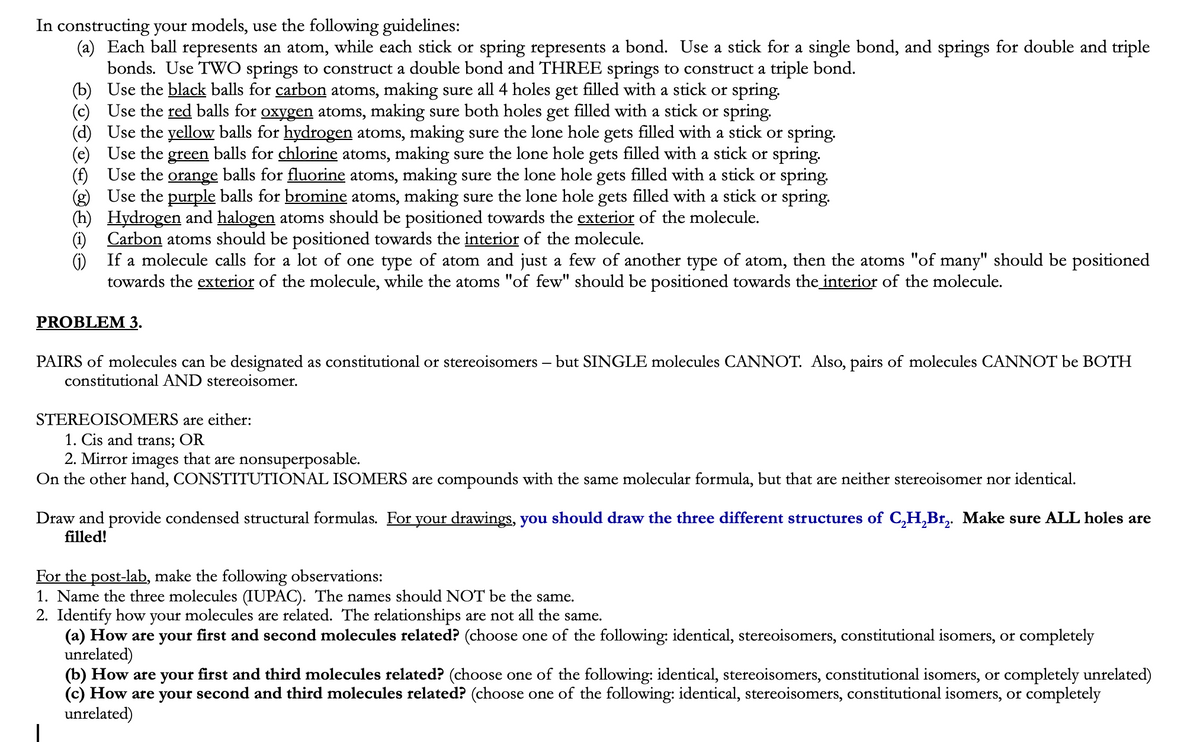In constructing your models, use the following guidelines: (a) Each ball represents an atom, while each stick or spring represents a bond. Use a stick for a single bond, and springs for double and triple bonds. Use TWO springs to construct a double bond and THREE springs to construct a triple bond. (b) Use the black balls for carbon atoms, making sure all 4 holes get filled with a stick or spring. Use the red balls for oxygen atoms, making sure both holes get filled with a stick or spring. (c) (d) Use the yellow balls for hydrogen atoms, making sure the lone hole gets filled with a stick or spring. Use the green balls for chlorine atoms, making sure the lone hole gets filled with a stick or spring. (e) Use the orange balls for fluorine atoms, making sure the lone hole gets filled with a stick or spring. (f) (g) Use the purple balls for bromine atoms, making sure the lone hole gets filled with a stick or spring. (h) Hydrogen and halogen atoms should be positioned towards the exterior of the molecule. ) Carbon atoms should be positioned towards the interior of the molecule. If a molecule calls for a lot of one type of atom and just a few of another type of atom, then the atoms "of many" should be positioned towards the exterior of the molecule, while the atoms "of few" should be positioned towards the_interior of the molecule. PROBLEM 3. PAIRS of molecules can be designated as constitutional or stereoisomers – but SINGLE molecules CANNOT. Also, pairs of molecules CANNOT be BOTH constitutional AND stereoisomer. STEREOISOMERS are either: 1. Cis and trans; OR 2. Mirror images that are nonsuperposable. On the other hand, CONSTITUTIONAL ISOMERS are compounds with the same molecular formula, but that are neither stereoisomer nor identical. Draw and provide condensed structural formulas. For your drawings, you should draw the three different structures of C,H,Br,. Make sure ALL holes are filled! For the post-lab, make the following observations: 1. Name the three molecules (IUPAC). The names should NOT be the same. 2. Identify how your molecules are related. The relationships are not all the same. (a) How are your first and second molecules related? (choose one of the following: identical, stereoisomers, constitutional isomers, or completely unrelated) (b) How are your first and third molecules related? (choose one of the following: identical, stereoisomers, constitutional isomers, or completely unrelated) (c) How are your second and third molecules related? (choose one of the following: identical, stereoisomers, constitutional isomers, or completely unrelated)
Electron Affinity
When an element undergoes a chemical reaction, it either gains energy or loses energy. This gain or loss of energy is due to the phenomena that occur at atomic level. During reaction, atoms either gain electrons from other atoms or lose electrons to other atoms, and in that process, energy is produced.
P-Block Elements
Elements which are present on the right side of the periodic table are called p-block elements. In addition to the noble gases, they include the families of boron, mercury, nitrogen, oxygen and fluorine. These elements have diverse real-life implementations that we regularly experience around us.
Metals and Non-metals
The periodic table is composed of metals, semi-metals and nonmetal elements. The physical and chemical properties of metals and nonmetals differ from each other. The study of metals and nonmetals will help one to understand the appropriate application of the particular element.

Trending now
This is a popular solution!
Step by step
Solved in 6 steps with 2 images






